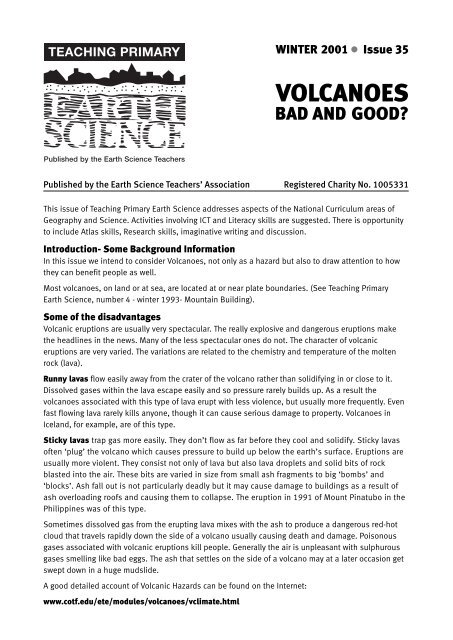teaching - Earth Science Teachers' Association
teaching - Earth Science Teachers' Association
teaching - Earth Science Teachers' Association
You also want an ePaper? Increase the reach of your titles
YUMPU automatically turns print PDFs into web optimized ePapers that Google loves.
WINTER 2001 ● Issue 35<br />
VOLCANOES<br />
BAD AND GOOD?<br />
Published by the <strong>Earth</strong> <strong>Science</strong> Teachers<br />
Published by the <strong>Earth</strong> <strong>Science</strong> Teachers’ <strong>Association</strong> Registered Charity No. 1005331<br />
This issue of Teaching Primary <strong>Earth</strong> <strong>Science</strong> addresses aspects of the National Curriculum areas of<br />
Geography and <strong>Science</strong>. Activities involving ICT and Literacy skills are suggested. There is opportunity<br />
to include Atlas skills, Research skills, imaginative writing and discussion.<br />
Introduction- Some Background Information<br />
In this issue we intend to consider Volcanoes, not only as a hazard but also to draw attention to how<br />
they can benefit people as well.<br />
Most volcanoes, on land or at sea, are located at or near plate boundaries. (See Teaching Primary<br />
<strong>Earth</strong> <strong>Science</strong>, number 4 - winter 1993- Mountain Building).<br />
Some of the disadvantages<br />
Volcanic eruptions are usually very spectacular. The really explosive and dangerous eruptions make<br />
the headlines in the news. Many of the less spectacular ones do not. The character of volcanic<br />
eruptions are very varied. The variations are related to the chemistry and temperature of the molten<br />
rock (lava).<br />
Runny lavas flow easily away from the crater of the volcano rather than solidifying in or close to it.<br />
Dissolved gases within the lava escape easily and so pressure rarely builds up. As a result the<br />
volcanoes associated with this type of lava erupt with less violence, but usually more frequently. Even<br />
fast flowing lava rarely kills anyone, though it can cause serious damage to property. Volcanoes in<br />
Iceland, for example, are of this type.<br />
Sticky lavas trap gas more easily. They don’t flow as far before they cool and solidify. Sticky lavas<br />
often ‘plug’ the volcano which causes pressure to build up below the earth’s surface. Eruptions are<br />
usually more violent. They consist not only of lava but also lava droplets and solid bits of rock<br />
blasted into the air. These bits are varied in size from small ash fragments to big ‘bombs’ and<br />
‘blocks’. Ash fall out is not particularly deadly but it may cause damage to buildings as a result of<br />
ash overloading roofs and causing them to collapse. The eruption in 1991 of Mount Pinatubo in the<br />
Philippines was of this type.<br />
Sometimes dissolved gas from the erupting lava mixes with the ash to produce a dangerous red-hot<br />
cloud that travels rapidly down the side of a volcano usually causing death and damage. Poisonous<br />
gases associated with volcanic eruptions kill people. Generally the air is unpleasant with sulphurous<br />
gases smelling like bad eggs. The ash that settles on the side of a volcano may at a later occasion get<br />
swept down in a huge mudslide.<br />
A good detailed account of Volcanic Hazards can be found on the Internet:<br />
www.cotf.edu/ete/modules/volcanoes/vclimate.html

















